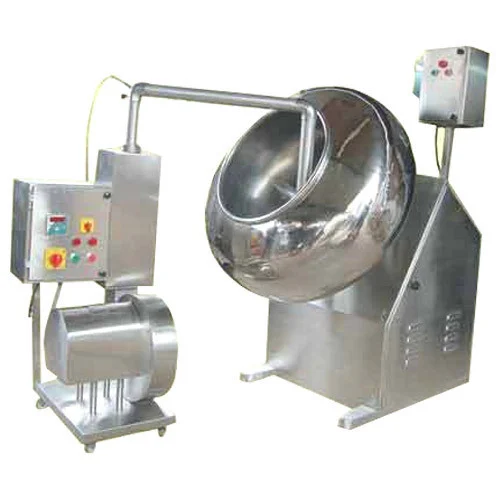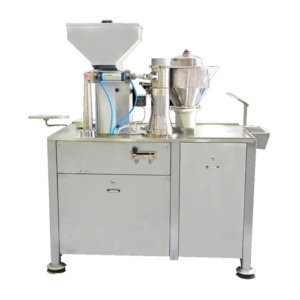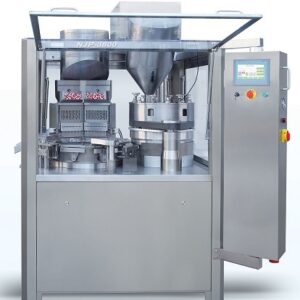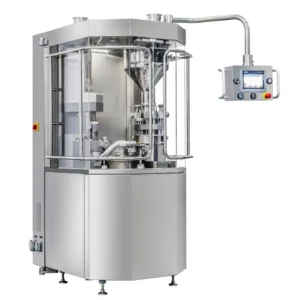Description
| Parameter | Specification |
|---|---|
| Model | XYZ-SCM-2000 |
| Capacity | 500-2000 kg/hour |
| Coating Drum Diameter | 1200 mm |
| Coating Drum Length | 2000 mm |
| Power Supply | 3-phase, 380V/50Hz |
| Power Consumption | 7.5 kW |
| Air Supply | 0.4-0.6 MPa (Compressed air) |
| Air Consumption | 1.5 m³/min |
| Heating Method | Electric Heating (Optional: Steam Heating) |
| Temperature Control | PLC Control System |
| Material | Stainless Steel 304 (Contact Parts) |
| Coating Material | Sugar, Chocolate, etc. |
| Coating Thickness Range | 0.5-2.0 mm |
| Rotation Speed | 0-32 rpm (Variable Speed Control) |
| Spraying System | Air atomization system with adjustable nozzles |
| Dimension (LxWxH) | 2500 x 1400 x 1800 mm |
| Weight | 1200 kg |
Sugar-coating machines have become an essential commodity in various industries, especially food and pharmaceuticals. These machines are crucial in improving the taste, texture, and appearance of products. The sugar-coating process does not only add sweetness to candies or pills. Sugar coatings also provide protective barriers and enhance the overall quality of a product. In this article, we discuss what sugar-coating machines do; placing focus on their working principle, applications, functions, future trends, roles, and advantages.
Working Principle
The process of sugar coating involves applying a thin layer of sugar syrup onto a core material such as nuts, seeds, or even tablets for pharmaceuticals. This action is facilitated by sugar-coating machines that guide through several steps:
Preparation of Sugar Syrup: The first thing is making a solution for the sugar syrup used in this process. This may comprise mostly sugar dissolved in water with additives like colorings or flavoring agents sometimes being included too. Syrup has got specific temperature degree for thickening it.
Core Material Rotation: The core material can be anything from tablets to candy and nuts. To ensure uniformity in the coverage process this machine rotates continuously.
Spraying Sugar Syrup: While rotating on its axis as described above, nozzles or spray guns apply the syrup onto the surface of this core material (Kulkarni & Shete).
Drying Process: Following the application of syrup containing glucose onto materials being coated these coats will undergo drying processes which include hot air treatment or perhaps solidifying them in drums meant for cooling them down where necessary.
Polishing: The addition of wax coatings or polishing agents can give the product a shiny appearance after it is finished being coated with sugar.
At the end of these stages what you get is smooth glazed sugars that make your snacks tastier due to their texture modification besides enhancing their general outlook (Sivakumar et al.).
Applications
- Pharmaceutical Industry: Used for coating pills and tablets to mask bitter tastes, control the release of active ingredients, and improve appearance.
- Confectionery Industry: Ideal for coating candies, chocolates, and nuts to enhance flavor, texture, and appearance.
- Food Processing: Applied for coating various food products, such as cereal grains or dried fruits, to add flavor and improve shelf-life.
- Research and Development: Utilized for experimental purposes in creating novel coatings for different types of substrates.
- Quality Control: Helps ensure uniform coating thickness and adherence, maintaining product consistency and quality.
Food Industry
Candy Manufacturing: Sugar coating machines are used in the manufacture of chocolates covered nuts, gummies, and hard candies. The sugar coating helps in extending the life of candy by protecting it from damage.
Snack Foods: Sweet and crunchy snacks can be made by sugar-coating nuts, seeds, and dried fruits, which are loved by most people.
Bakery Products: Some bakery items such as cookies, biscuits, and pastries have also been sugar-coated to improve their taste and appearance.
Pharmaceutical Industry
Tablet Coating: In pharmaceuticals tablets or pills can be seen being covered with sugars using machines that perform this function. It makes tablets palatable through the provision of sugar coatings; also it may be useful when masking undesirable tastes or smells.
Controlled Release: Sugar coatings can act as a barrier that controls the release rate of drugs (Rajan et al., 2003).
Functions of Sugar Coating Machines
Enhanced Taste: Consumers find products sweet due to the presence of sugar coatings on them.
Texture Improvement: The coating provides a soft yet crispy feel thereby enhancing satisfaction derived from eating the final product.
Protection: This type of glossy layering enables liquid absorption prevention while food stays much longer on storage shelves.
Sugar coating machines, which are employed in various industries like food and pharmaceuticals, add a thin layer of sugar syrup to core materials and thus improve their taste, texture, and look.
Future Trends
The industry of sugar coating is ever-evolving due to technological advancements and changing consumer preferences. Some future trends in sugar-coating machines include:
Automation: The demand for automation in manufacturing processes, including sugar coating, continues to rise. In the future, sugar grain machines will be more automated with improved efficiency and precision through robotics and advanced control systems.
Customization: As diverse consumer preferences continue emerging, there has been a move towards customization in both food and pharmaceutical products. Sugar Coating Machines could have more options regarding the thickness of the coatings, and variation of colors and flavors to satisfy different customers.
Healthier Options: Increased awareness of health and wellness has led to a rising demand for healthy foods as well as healthier pharmaceuticals. Future Sugar Coating Machines may be built with alternatives like natural additives or other sweeteners that will cater to this aspect.
Integration of IoT and Data Analytics: Sugar-coating machines can integrate IoT (Internet of Things) technology with data analytics that monitors real-time manufacturing process optimization. This leads to better product quality as well as reduced waste and improved efficiency.
Green Manufacturing: Many sectors now concern themselves with sustainability issues such as the food sector, pharmaceutical industries, etc. Eventually, even these machines may be made from environmentally friendly materials using eco-friendly processes so that their overall effect on nature is minimal.
Roles and Advantages
Sugar coating machines play important roles in different industries hence having several advantages:
Product Enhancement: To make them more appealing to consumers, products are always subjected to sugar-coating treatment for taste texture improvement.
Extended Shelf Life: When products are coated with sugar it creates a protective layer around them preventing moisture absorption thereby increasing their shelf life.
Improved Palatability: For instance, sugaring drug pills taken by adults who do not like taking medication would make it easier especially children who swallow drugs very hard because they are very bitter.
Versatility: From candies and snacks up to tablets in medicine production; sugar coating machines can coat a wide range of products thus making them valuable equipment to manufacturers.
Cost-Effectiveness: Sugar-coating machines are cost-effective in the long run due to improved production efficiency, low-cost labor, and reduced product wastage despite the high initial cost associated with investing in them.
Consistency: When sugar coating machines are automated, they guarantee evenness in coating thicknesses, colorization effects, and texture; this leads to consumer satisfaction and uniformity of product quality.
Compliance: In pharmaceutical industries sugar grain machines help comply with taste masking requirements for drugs as well as other aesthetic-related concerns that regulators always raise.
FAQs
- What is a sugar-coating machine?
A sugar coating machine is a piece of equipment used in industries such as food and pharmaceuticals to apply a thin layer of sugar syrup onto the surface of core materials, enhancing their taste, texture, and appearance.
- What are the main applications of sugar-coating machines?
Sugar coating machines are primarily used in the production of candies, snacks, bakery items, and pharmaceutical tablets. They help improve product palatability, extend shelf life, and comply with regulatory requirements in the pharmaceutical industry.
- How does a sugar-coating machine work?
The working principle of a sugar coating machine involves preparing a sugar syrup solution, rotating the core material while spraying it with the syrup, drying the coated material, and optionally polishing it to achieve a smooth finish.
- What are the benefits of using sugar-coating machines?
Some benefits of using sugar coating machines include enhanced taste and texture of products, extended shelf life due to protective coating, improved palatability of pharmaceutical tablets, versatility in coating various types of products, and cost-effectiveness through automation and reduced wastage.
- Can sugar-coating machines accommodate different types of coatings?
Yes, sugar coating machines can accommodate various types of coatings, including colored coatings, flavored coatings, and coatings with different textures. This allows for customization of products to meet consumer preferences.
- Are sugar-coating machines suitable for small-scale production?
Yes, sugar-coating machines come in various sizes and configurations, making them suitable for both small-scale and large-scale production. Manufacturers can choose the machine size and capacity that best fits their production needs.
- How do sugar-coating machines contribute to product quality control?
Sugar coating machines contribute to product quality control by ensuring consistency in coating thickness, color, and texture. This leads to uniform product quality and consumer satisfaction.
- Are sugar-coating machines easy to clean and maintain?
Most sugar-coating machines are designed for easy cleaning and maintenance. They are typically made of stainless steel or other easy-to-clean materials, and some feature detachable parts for thorough cleaning.
- Can sugar-coating machines be used for coating non-food items?
While sugar-coating machines are primarily used for coating food items, they can also be adapted for coating non-food items such as pharmaceutical tablets, seeds, nuts, and even industrial components in some cases.
- Are there any safety considerations when using sugar-coating machines?
Safety considerations when using sugar coating machines include following proper operating procedures to prevent accidents, ensuring the machine is properly maintained and inspected regularly, and providing appropriate training to operators on machine operation and safety protocols. Additionally, proper ventilation may be necessary when using certain types of coatings to prevent exposure to fumes or dust.





Reviews
There are no reviews yet.